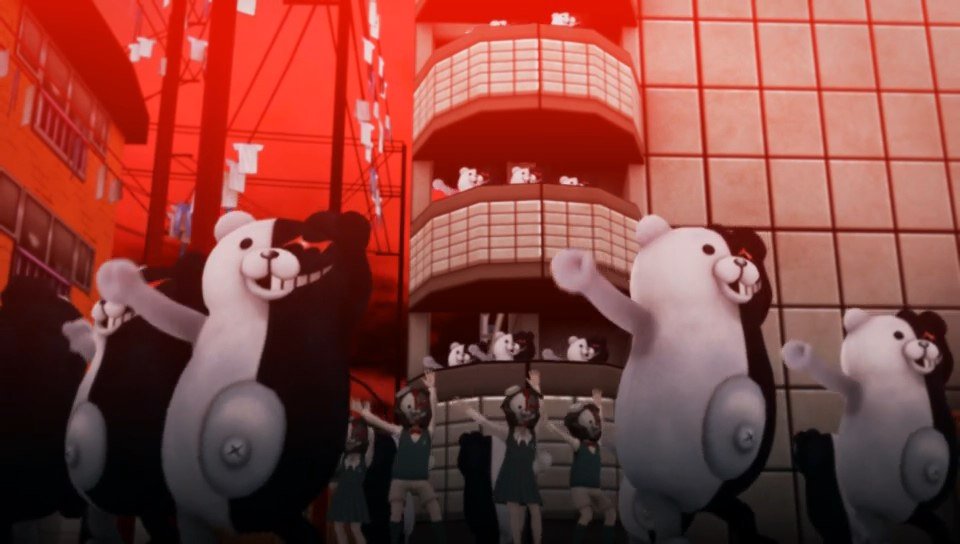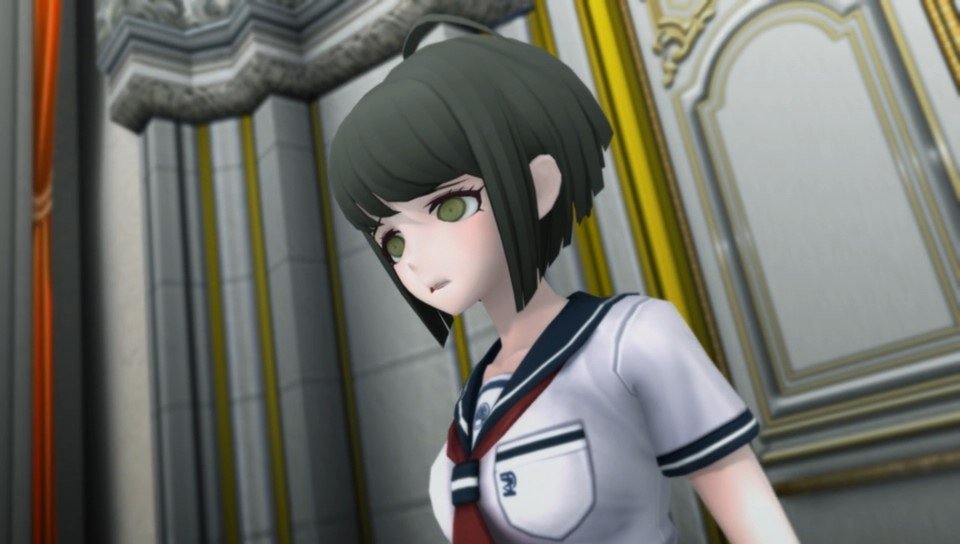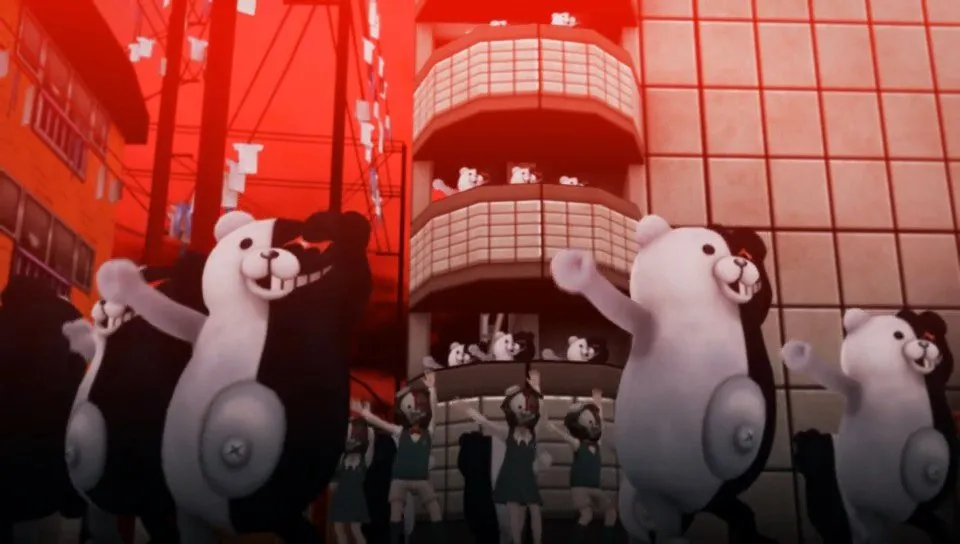There are Monokumas everywhere. On the streets, atop buildings, in the subway. And they take on different forms. Beast Monokumas, Bomber Monokumas, Monokumas with riot shields – they’ve infested the once peaceful Towa City.
The third game in Spike Chunsoft’s Danganronpa series, Danganronpa Another Episode: Ultra Despair Girls (quite a mouthful, that) finds itself sandwiched between Danganronpa: Trigger Happy Havoc and Danganronpa 2: Goodbye Despair, but, unlike most sequels, it’s quite different to its brethren; while they focussed heavily on story with minimalist gameplay, Ultra Despair Girls changes tact completely, stretching its legs and adopting the form of a third person shooter.
And it works. Sort of.

You play, primarily, as Komaru Naegi, the younger sister of Makoto, Danganronpa’s main protagonist. Pursuant to the events of Danganronpa: Trigger Happy Havoc, you find yourself in a world overrun by Junko Enoshima’s physical, robotic embodiments of despair.
But there’s no Killing Game – the notoriously tense and masochistic killing quest that pitted friends against friends and classmates against classmates is all but gone. It’s one of the many brave departures that Ultra Despair Girls makes from the much-loved formula, but what’s very much here to stay is the overarching struggle between hope and despair, and it remains the lifeblood that drives the story. The game touches upon darker, more serious themes, too, but Komaru’s main goal is very much to escape Towa and overcome despair.
Speaking of which, Towa City itself is, to say the least, atmospheric. An ominous red sky hangs overcast, while little children adorned with Monokuma helmets dance and clap around the bodies of deceased adults. Komaru quickly finds herself thrown onto the streets thanks to the Warriors of Hope, a five piece band of malevolent children with twisted desires, who induct her as the latest prey in their goal to murder all adults, or, as they call them, Demons. The Warriors of Hope have a seemingly deep-rooted hatred for their elders, and this sadistic group of demonic children do a more than capable job of replacing Junko Enoshima as the harbingers of despair and chaos.

There’s a lot to like about Ultra Despair Girls. The series’ humorous writing, unique character designs and fourth-wall breaking moments are back with aplomb, and the continuous back and forth between Komaru and the returning Toko Fukawa adds levity to even the most despair-inducing situations. But it’s also where the cracks begin to show. Ultra Despair Girls feels too grounded in its visual novel roots. A change of genre shifts the goalposts and changes expectations, which is why I was so often frustrated by being continuously robbed of control in favor of mundane chatter that felt needlessly prolix. It’s annoying, unnecessary and it hurts the game’s pacing.
The story too, while certainly interesting, doesn’t quite live up to the high standards set by its predecessors. Komaru is just as ordinary, just as average and just as plain as her brother. Both are blank canvases, but Makoto was surrounded by an eclectic cast of characters that helped paint a pretty picture. The cast of Ultra Despair Girls is limited by comparison, and Komaru stands as a likeable but annoyingly timorous character, while the Warriors of Hope feel like missed opportunities – they’re undoubtedly the most interesting and complex characters in the game, I only wish that we got to see more of them.
Take a trip back to Danganronpa, if you will. Its most excruciating, most painful and most emotionally draining moments came when the bond you had forged with your favourite character was taken away by their untimely death. You’d meet characters, fall in love with them, only to see them die moments later. This sense of fear generated a perpetual tension, and the investigation into the perpetrator could lead to equally earth-shattering moments. Ultra Despair Girls is lacking in all of these respects. It tells an interesting story, but one without the same hook, the same sense of mystery, the same brilliantly bizarre characters and, ultimately, I was without the same level of investment.

It is the gameplay that, surprisingly, stands as the most fun and engaging element of Ultra Despair Girls. As Komaru, you use the Hacking Gun to fire bullets at a litany of Monokumas. It starts simple, with basic ammunition and enemies that are limited in their capabilities, but progression is married with variety, spawning new bullets and new Monokumas that instil a sense of strategy and a refreshing change of pace. Take the Link Bullet for example, which allows the control of enemy Monokumas. Or the Move Bullet, that allows you to move cars to take out a whole host of Monokumas all at once. It’s further strengthened by Toko’s presence. More than an impotent bystander, you’ll take advantage of her split personality and help thin the herd as Genocide Jill, albeit for a limited time. That’s all broken up by a series of challenges, riddles, puzzle-like segments and the quest for the game’s many, many collectibles.
When the credits rolled, after what was a satisfying climax, I felt a sense of ambivalence towards Ultra Despair Girls. So much I love about the series is here: its writing, its music, its unique character designs, but there’s also a lot that left me frustrated. The story is poorly paced, there’s too many needless interruptions, and the jaw-dropping, mind-blowing and grandiose twist never came.
The Verdict
Ultra Despair Girls is the weakest Danganronpa game. But that’s like saying Mass Effect 1 is the weakest Mass Effect, or Uncharted 3 is the weakest Uncharted. Yes it can get annoying, yes its story isn’t as good as its predecessors and yes, its characters are fewer and generally less memorable, but it remains a game that every Danganronpa fan should still experience.











Published: Aug 27, 2015 10:48 am